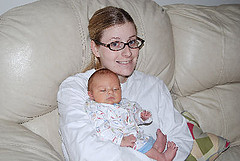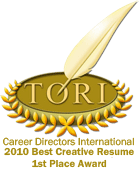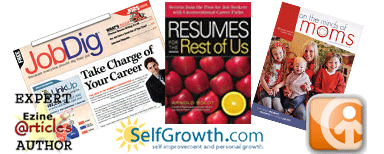 Recently, two career industry colleagues and I presented a webinar for more than 100 University of Pennsylvania alumnae regarding the issues women face when returning to work. We received such a high level of interest and response that we agreed to share our information here, as well. This post is part of my own presentation. (You may view the entire webinar including audio and text questions and answers with each career expert.)
Recently, two career industry colleagues and I presented a webinar for more than 100 University of Pennsylvania alumnae regarding the issues women face when returning to work. We received such a high level of interest and response that we agreed to share our information here, as well. This post is part of my own presentation. (You may view the entire webinar including audio and text questions and answers with each career expert.)
When women re-enter the workforce after a substantial hiatus, regardless of the reason, they are usually worried about The Gap. “What do I put on my resume during the time I wasn’t working?” they wonder. There is no need to hide the gap. Most attempts fail anyway. If you were raising children or caring for an elderly parent, your title is Care Giver or Family Care Giver.
Illness or disability is a touchier matter because employers worry about your ability to do the work. If you were ill, call the time a Professional Sabbatical. Health questions are prohibited in interviews, and in this case, the less said the better. As long as you are able to perform the duties required, you’re OK.
If you can perform the duties with accommodations, you will at some point need to ask for the accommodations. Opinions vary on when and how to do this. Ask your local Vocational Rehabilitation office, advocate, or case manager for recommendations suited to your specific needs.
It definitely helps if you have some part-time, consulting, free-lance, or volunteer experience during your time away from your career. List it, to be sure. If you don’t have this type of experience, then think of the parts of your recent time at home that pertains to the job you want. I can’t be the only person in the world who has noticed the similarity between parenting tasks and management tasks, for example.
Here are some basic rules for a resume to help you re-enter the workforce.
1. Prepare for a gap in your experience.
Even if you can’t choose whether to leave your job, you can choose to stay involved in your career. Volunteer experience counts. Mom experience counts. Household management experience counts. Elder care counts. Don’t discount ANY of your experience even if everyone else does. Just make sure to include ONLY the parts of it that pertain to your target position.
Earlier in my career, I was ill and unable to work for about 2 years. The doctor who helped me recover was writing a book and needed help with editing and a Web site. I volunteered, working when I felt able. It wasn’t a full-time job, but there is a section of my resume that would have been blank had I not taken on the responsibility. Even at the time, it was very important to my emotional health to be able to accomplish something, however small.
2. Network.
Your resume isn’t the magic wand that will get you a new job. Its job is to represent you on paper when you’re not there. When you’re ready to go back to work, you need someone to send the resume to. Stay in touch with people from work or at least in your career field. Create and use a LinkedIn profile for networking. Also, use it to find out about people working in your target companies. Join LinkedIn groups and/or meet-ups of professionals in your field to keep up with the advancements in your industry.
3. Choose your target before you write your resume.
General resumes do not work. One more time to make sure I have your attention: General resumes do NOT work. “I want to keep my options open” means you don’t want to choose, and your job search is likely to be long, confusing, and painful. For some, the target will be obvious because you want the same job or type of job you left. For others, you will be changing careers and figuring out what that target is. In either case, knowing your target is the essential first step. (If you’re stuck on this step, contact me right away. I offer the Career Exploration Program that has helped 100% of the people who have completed it to move on with their career decision.)
4. Research your target companies.
Use www.Glassdoor.com to determine where you want to work. Network with people in companies you admire. Send them your resume and ask if they know of any jobs that will be open soon for which you might be qualified.
5. Collect job postings for your target position.
Use those postings as guides to the main points of your resume content. Employers tell you what they want. You don’t have to guess.
6. Tailor your resume and cover letter to each application.
Tell how your experience applies to the company’s needs. This must be clear. Recruiters and hiring managers want to know if you fit their requirements, and they will spend only seconds finding out.
7. Choose only relevant material.
A resume is a marketing tool. One of my clients had 10 years of computer programming experience, and her target position was event planning. Her computer experience took up exactly 1 line on her resume. It mattered that she had held a responsible position before raising her children. It didn’t matter that she had programmed in Cobol when she wanted to be an event planner.
8. Focus on accomplishments.
Don’t spend a lot of time and space listing your responsibilities and duties. Everyone applying for a sales position probably can run SalesForce, use excellent customer service skills, and sell products. Instead, be specific about your experience. Use examples as evidence of your level of accomplishment. Not everyone has “Increased departmental sales revenue 40% in one year by creating and hosting quarterly VIP open house events.”
9. Use a chronological style resume.
Even though you may feel that a skills-based or functional resume could highlight the things about you that are more important, don’t use it. Hiring managers and recruiters think functional resumes are trying to hide something. Rather than fight the stereotype, make the information in each position extraordinarily relevant to your target. You can see samples of excellent re-entry resumes below.
10. Follow ATS guidelines.
Applicant Tracking Systems, the computers that scan your resume before it is seen by human eyes, determine much of how resumes are written now. Find out what you need to do to comply with their requirements.
- Samples of resumes I have written . These have been fictionalized to preserve confidentiality and are shared with permission.
- Executive Director
- Supply Chain & Procurement Executive
- English as a Second Language Instructor
- Certified Diver (Retirement Job)
- Franchise General Manager
- Construction Project Manager
- Communications Professional
- Manager / Administrator
You may view the entire webinar including audio and text questions and answers with each career expert.
Related
Women returning to work: The Reasons
Women returning to work: Your Brand
Photo credit: Mylissa









Jeri, this is succinct advice covering a broad spectrum of issues for women returning to work. No wonder you and your co-presenters received such acclaim!
Thanks, Pat! It really was a fun webinar. Participants asked such great questions, too. I knew workforce re-entry was an issue, but even with my first-hand experience, I didn’t know the level of worry it causes so many women.